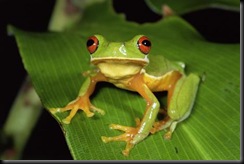An antibiotic primarily used to treat pinkeye in humans rids frogs of the fungal disease that is wiping out amphibian populations around the world, a team of New Zealand scientists reports.
Infected frogs treated with the drug for two weeks were cured of the deadly disease, called chytridiomycosis or frog chytrid disease.
The fungal disease, along with habitat destruction and global warming, is blamed for putting more than a third of the world's 6,234 known amphibian species on the path to extinction.Scientists have been racing to find a way to curb the disease before it takes an even heavier toll. The antibiotic chloramphenicol is "definitely the best" treatment found to date, Bishop said.
Another drug, itraconazole—which is used to treat fungal and yeast infections in humans—has also been shown to cure chytrid disease. But the drug causes kidney damage in some frogs, he noted.
Itraconazole also remains under patent protection and is therefore expensive, whereas chloramphenicol is generic and widely available.
Captive Tests
Allan Pessier is a veterinary pathologist at the San Diego Zoological Society in California and an expert on the deadly fungal disease. He said more tests are needed before declaring one drug better.
Both drugs, he added, are effective treatments for captive frogs but are probably never going to see widespread use in the wild as a spray or liquid dumped into streams and ponds.
"It's a step that helps us manage the disease, but it's not like declines associated with chytridiomycosis are going to go away because of this discovery," he said.
To be effective in the wild, scientists would need to overcome hurdles like maintaining sufficient concentrations of the drug in the environment without harming the ecosystem, he noted.
Bishop's colleague, biochemist Russell Poulter of Otago, stumbled upon chloramphenicol while running a battery of tests on various antibiotic and antifungal compounds in search of any that may prove effective against chytrid disease.
"It was a very surprising result to find an antibacterial that killed a fungus," Bishop said.
The researchers used the compound both as an over-the-counter ointment applied to infected frogs' skin and as a solution soaked into a paper towel on which the frogs sat.
"We found that after about 18 days we could swab the frogs again and they would be cured of chytrids," Bishop said.
The team tested the compound on three species in New Zealand: the brown tree frog and the southern bell frog—which were introduced from Australia—and the critically endangered native Archey's frog.
Bishop said all the frogs are still alive and well 12 months after treatment. Researchers at the Taronga Zoo in Sydney, Australia, are now testing the drug on six more endangered frog species.
Why the drug kills the fungus, he added, remains under investigation.
Drug Resistance?
The New Zealand researchers also tried to re-infect frogs that had been successfully treated. The frogs again contracted the disease, but it disappeared within a few days.
Bishop is uncertain why the frogs were "difficult to re-infect." Perhaps the chloramphenicol lingers in their skin or it works like a vaccine, priming the amphibian immune system to thwart the fungus, he said.
"We're hoping this is going to be something really significant, and we are currently investigating that," he added.
Reid Harris is a biologist at James Madison University in Harrisonburg, Virginia, who studies chytrid disease. He agreed further studies are needed to investigate the apparent disease resistance.
"The more we can learn about any sort of mechanism of resistance ... the better," he said.
Conserving Frogs
Bishop and his colleagues are continuing to comb through various antifungal agents in search of one that is effective against chytrid disease.
Antifungals, he noted, may prove more acceptable to spraying in the wild than chloramphenicol or itraconazole.
"People don't want antibiotics being dumped in vast quantities in the environment," he said.
Meanwhile, Pessier of the Zoological Society of San Diego said the antibiotics can be used to treat and maintain captive populations until a solution to the problem in the wild is found.
"If you didn't have that option," he said, "you'd see frogs going essentially extinct because of the infection."
Source:National Geographic

No comments:
Post a Comment